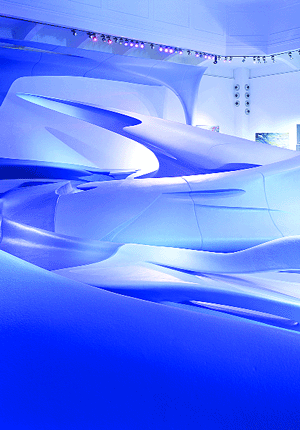Zaha Hadid’s forward thinking architecture
Zaha Hadid turns architecture on its head. Conceptually based, Iraqi-born Hadid’s projects were considered unbuildable, but recently several have been realized by forward-thinking institutions. The only woman to be awarded the impressive Pritzker Architecture Prize, in 2004, Hadid is pushing society into new visual and theoretical territory in our created/constructed world. She was influenced by Constructivism and designed the Guggenheim’s “Great Utopia” Exhibition in 1992.
The museum’s familiar sculptural rotunda is the send off point. Up the ramp are early projects including an attention grabbing unrealized design for a leisure club titled, “The Peak Hong Kong,” 1982-83, a dynamic floating mountain structure. Hadid creates paintings to explore her ideas. Described as confined explosions, the painted works are large with many angles and colors, presenting multiple views, much as in Cubism. The jumble of moving planes and energy are almost impossible to decipher, leaving more of an impression than a concrete visual. It is difficult to remember one painting distinctly from another, but all exude rigorous thought from many perspectives.
As you ascend, these paintings, drawings, and functional objects are punctuated by videos at various landings. The footage is very informative and gives a glimpse of the exciting, imaginative spaces created in some of the realized projects.
The soaring and angular spaces of the BMW Plant are astonishing, and there are social implications within. The building melts manufacturing and administration as the production line of cars passes above the office spaces, in a constant flow.
This building aids in breaking down barriers and encouraging communication and awareness between the company’s blue-collar and white-collar workers. The dynamic spaces are breathtaking and the video includes workers praising the environment. This project is stellar example of Hadid’s ideal, merging the creative, visual, and functional.
At the top ramp, the exhibit reaches a crescendo where ideas are rendered in three-dimensional models. The inclusion of a full-scale kitchen seems trite at the apex. At the pinnacle, all the paintings and drawings materialize into something readable; the feel is other worldly and truly futuristic. With few boxes or right angles, the emphasis seems to be thought-based rather than outer form. These models float and merge and blend and disappear simultaneously. In this exhibition Zaha Hadid raises the ante on the constructed future through her rigor and imagination.
gaycitynews.com


































